
Camping allows us to get a little closer to nature and spend more time in the great outdoors with family and friends. But there are many different ways to camp, whether it’s backpacking and sleeping in a sleeping bag under the stars, RV’ing, or tent sleeping. If you want to rough it in the wilderness, you can still enjoy a little safety and comfort when you’re out in the elements. The best cabin tent allows you to enjoy the best of both worlds by having just a few comforts of home, a protected, secure place to sleep at night, and a way to store your gear and supplies away from wildlife and safe from the wind and rain.
But before you run out and buy the first model you find on sale, there are many factors and characteristics that you should consider, such as durability, material type, size, price, and of course, quality. I’ve reviewed several models on the market, narrowing it down to five tents that check all the boxes. These models are versatile, beginner-friendly, budget-friendly, and designed to last.
Below, you’ll find a comparison chart that lists some of the similarities and differences between each of these models, including how they rated, pricing, capacity, and more.
Table of Contents
Cabin Tents Comparison Chart
| Product | Capacity | Style | Cost | Rating |
|---|---|---|---|---|
CORE Cabin Tent Check Price! Check Price! | 9 | Freestanding | $$ | |
Coleman Cabin Tent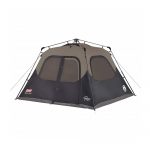 Check Price! Check Price! | 6 | Freestanding | $ | |
Ozark Trail Base Camp Tent Check Price! Check Price! | 14 | Traditional | $$ | |
ALPHA CAMP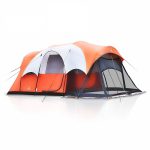 Check Price! Check Price! | 6 | Freestanding | $ | |
QOMOTOP 4 People Tent Check Price! Check Price! | 4 | Freestanding | $ |
Best Overall-CORE 9 Person Instant Cabin Tent
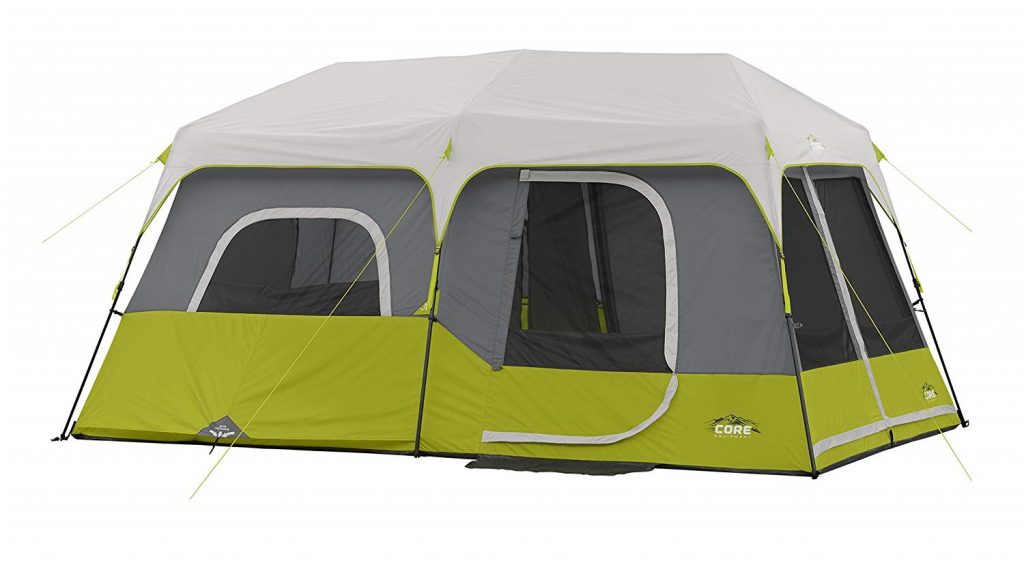
Our Rating:
The Core 9 features a spacious interior, an optional rainfly, a fast, sixty-second setup time, and a durable design that will allow you and your family to camp in total comfort. This is a leading three-season model that comes loaded with some great extras, including built-in storage and a pre-assembled frame. Its variety of mesh windows, the double entryway, and the included air vents work together to improve airflow, so you’ll stay nice and cool during the hotter summer months. It can easily accommodate up to nine campers and comes with a room divider for that extra level of privacy when you’re camping in the backcountry.
Fast Setup-Coleman Cabin Tent with Instant Setup
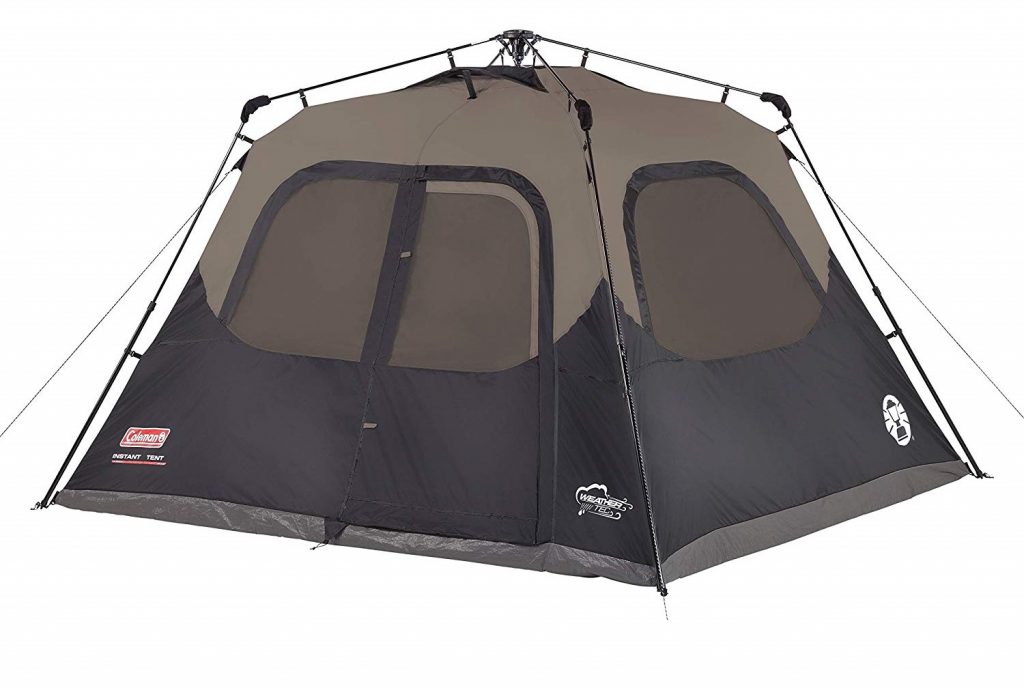
Our Rating:
This Coleman model features a high ceiling and a fast setup design that allows you to quickly assemble this model in under a minute. This is another popular three-season model that does an excellent job of keeping the interior of the tent nice and cool, even during the hotter months of the year, due to its dark-room technology, which can block out ninety percent of sunlight, so you can also sleep in a little later. Easy to set up and breakdown, spacious, and offering better than average airflow, this is a model you can really rely on in the backcountry.
Best Traditional Tent-Ozark Trail Base Camp 14-Person Cabin Tent

Our Rating:
If you’re looking for a larger tent that’s affordable and offers the type of privacy you need when camping out with a big group, then this Ozark Trail model is a great choice. The interior features a total of three bedrooms and one spacious common area, in addition to four entrances. Each room comes with a couple of windows and an additional window on the private entrance. While the assembly process is lengthy, to say the least, if you’re on a budget and need a durable tent that can provide all the space you’ll need and then some, this model is right up your alley.
Best Value-ALPHA CAMP 6 Person Cabin Tent

Our Rating:
This model can accommodate up to six campers and comes equipped with a large screened-in porch that can be used as an extra sleeping space, a place to store wet or muddy gear, or it can be a great place for the family to gather at night and enjoy the evening air. Inside, there are plenty of windows and a mesh ceiling, all designed to improve the airflow and prevent condensation buildup. Versatile, beginner-friendly, and a steal for the price, the latest model by Alpha Camp is pretty impressive.
Compact Design-QOMOTOP 4 People Easy Set Up Instant Cabin Tent
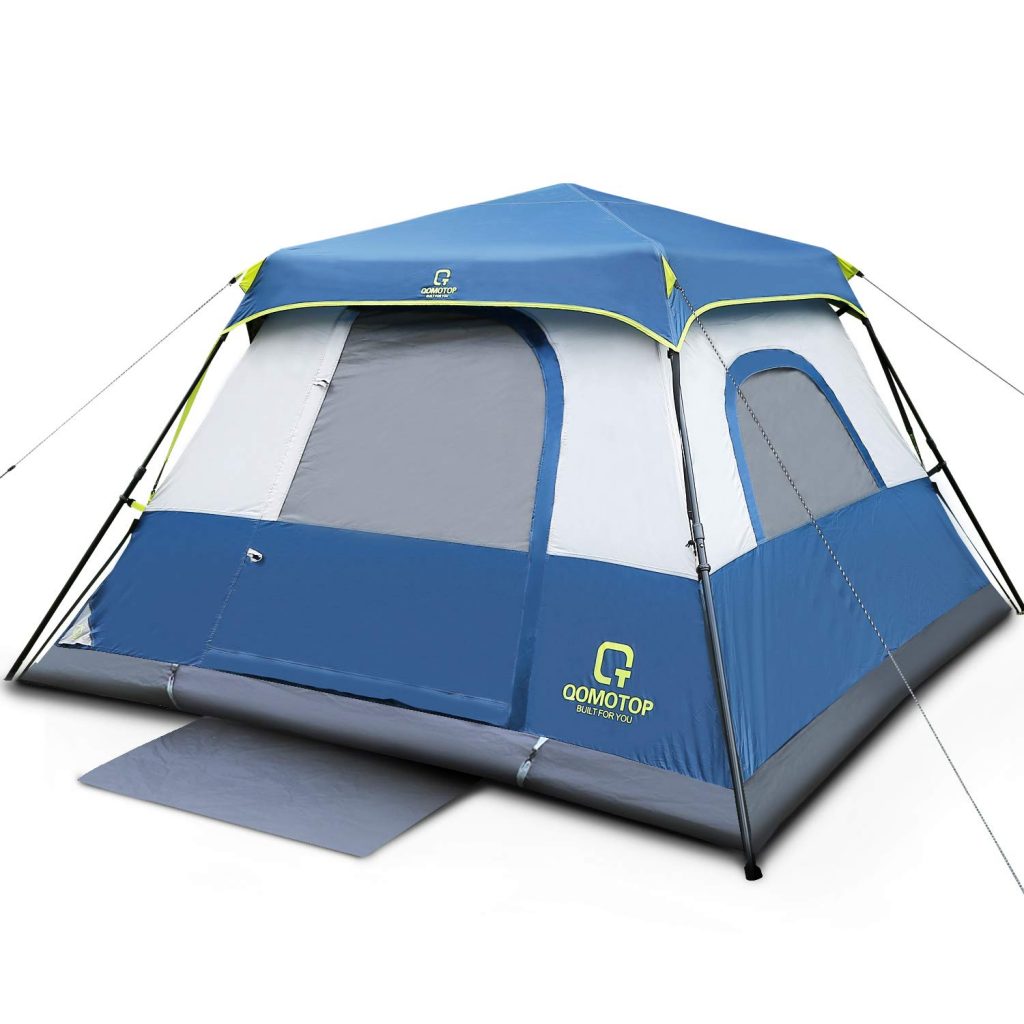
Our Rating:
If you need a cozy, comfortable tent that can sleep up to four people, then you’ll love what this model by Qomotop has to offer. It’s a three-season model that features excellent airflow, a fast setup time of just sixty seconds, and a built-in rainfly that can easily handle light to moderate rainfall. It also does an excellent job of keeping you nice and cool during the warmer months and features a compact folded design that makes it easy to transport.
Cabin Tents Buyer’s Guide
Camping is one of the most affordable, fun ways to enjoy quality time with friends and family, but if you’re caught out in a downpour in a model that can’t handle inclement weather, it can be enough to ruin your entire trip. Basically, a tent is one of the most important pieces of gear you’ll take camping and it can make or break your vacation.
Because of this, you’ll need the very best model, one that can handle heavy-duty use, and one that’s easy to assemble. But there are so many specs and features to look for in a tent that’s durable and designed to last. Considering there are several models on the market, finding one that’s right for your family can take some serious research on your part, but in the end, it’ll be worth it.
When you’re shopping around, one of the first specs you’ll want to look at is the tent’s size. If you have a large family, or you often enjoy camping trips with friends, then you’ll need to consider how much space you need, whether privacy is a priority, and how much extra space you will need for storing gear, bedding, and other supplies.
Capacity
First, consider the number of people that will be using the tent. Pay close attention to a tent’s dimensions, whether or not it has separate rooms with dividers, and how many people it sleeps. This information will be available on the spec sheet. I recommend buying a tent that’s slightly larger than what you need. This will accommodate any extra gear that’s brought along or any last-minute guests.
Keep in mind, just because the manufacturer lists that a tent can sleep three or four people that may not actually be accurate. At times, the manufacturer may be right on the mark, but in other cases, the tent may be too small to comfortably sleep the number of people the spec sheet claims it can. Because of this, you’re better off paying close attention to the dimensions.
Camping Environment
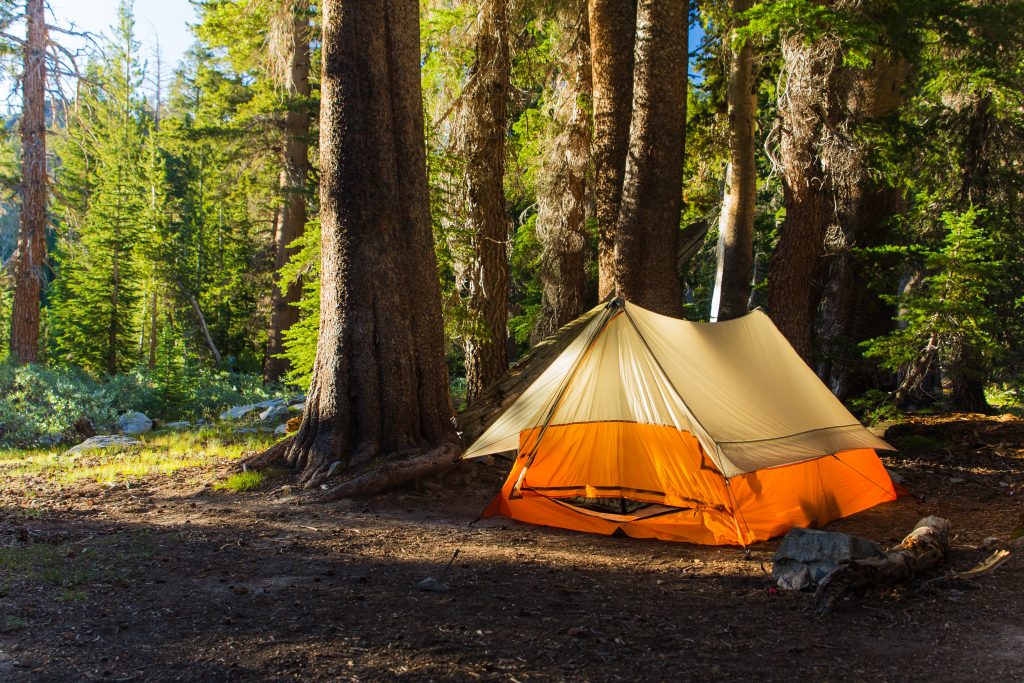
Where do you normally prefer to camp? National campgrounds are more accommodating and come with hookups for water and electricity, access to showers and bathrooms, and even a local general store. Backcountry camping is much different. You’ll be on your own in the wilderness, with no access to a bathroom for miles around, let alone electricity. Where you camp can also have an impact on the model you choose. If you’re camping in the backcountry, then you’ll need a tent that’s more durable and well-protected. In this type of environment, you’ll be more exposed to wildlife and the elements.
If you normally head to the local campground, you’ll still need a tent that can protect you and your gear from the elements, but most camping spaces are well-developed, are on level, dry ground and you are not quite as vulnerable to late-night wildlife visitors since animals tend to keep their distance from large groups of people.
Material
Camping out in a tent is still the most popular way to rough it in the wild, although yurts and camping pods are becoming increasingly popular. But a tent is a more affordable, fun way to spend time in the wilderness with family and friends. The material type will be another important feature that can determine quality and durability. There are many different types of materials to choose from. Some are more durable than others. Cheaper material tends to wear out over a period of one to two seasons, especially if you put up and break down a tent several times per season.
Cotton and Canvas
A canvas and cotton tent is pretty durable and can be a great option in both colder and hotter weather. The material combination will keep you nice and warm in the winter months while helping to prevent heat from entering the tent during the summer months. The material is also highly breathable.
Tents made out of all canvas have to undergo a weathering-in period for it to be considered fully weatherproof.
Polycotton
Polycotton consists of a material blend that’s made from both cotton and polyester. It’s a great alternative to canvas tents since it’s more forgiving in terms of weight. It also usually has a light waterproof coating that will protect you from the elements.
Nylon
This is by far, the most popular choice. Most lower-priced tents are made out of nylon. Nylon fibers don’t absorb water so the material can be made thinner. It’s also coated with polyurethane, acrylic, or silicon to further enhance the material’s waterproofing abilities. Most backpackers opt for this type of material since it’s lightweight and won’t weigh down a pack. In terms of full-sized models, it can also be a great choice if you’re on a tight budget, but it’s not the most durable material.
Polyester
Models that are made out of polyester are designed to easily withstand long-term exposure to the sun, unlike nylon. However, it’s not exactly the most breathable of materials. If you do decide to buy a model made out of polyester, make sure it comes equipped with a type of breathable coating, one that will improve airflow but prevent water from entering the cabin. Tents without this type of coating often have issues with condensation buildup, which can make it feel like you’re living in your own personal sauna.
Style

Models labeled as three or four-season point toward the tent’s durability and ability to handle certain types of weather conditions.
- A three-season model is a more popular choice. These tents are designed to handle milder weather conditions and can be a great choice for the fall, spring, and summer. Most come with several mesh panel windows, which are designed to promote air circulation. They also help to keep mosquitos and other insects at bay. In terms of the elements, most can handle downpours, however, they aren’t the best choice when it comes to dealing with prolonged exposure to inclement weather.
- Extended season tents are designed for prolonged use during the fall, spring, and summer months. These are best suited for the summer months, however, they can handle colder temperatures rather well. They’re designed to retain warmth, offer a highly breathable design, and have a reputation for being more durable than the standard three-season tents.
- Four season tents are by far the most durable and can withstand, heat, colder temperatures, rain, and even snowfall. Just like the name sounds, these tents can be used for every season. These models feature heavier material and more poles than the three-season and extended season tents.
They often feature a dome design that prevents snowfall from building up. In terms of breathability, they don’t come equipped with as many mesh panels as other styles, which can have an impact on airflow. However, if you often camp out during the rainy season or the winter months, they can be a true lifesaver and do an excellent job of providing protection from the elements.
Height
Height can be another important spec, especially for campers six feet or taller. If you want to be able to stand up straight when walking around inside, check out the spec sheet for height dimensions. There are many models these days that come with a higher than average peak height. Most cabin style models will also feature a near-vertical wall design which will boost a model’s peak height.
Dome style models will offer better than average strength and a taller center, however, the walls have a tighter slope design which tends to make them feel more cramped.
Doors
If you’re camping with your family or friends, then having more than one entrance is a must. Consider how many doors you’ll need so you can avoid a pileup when it’s time to leave or head back indoors. Most models will come with a minimum of two. These doors will open and close via a YKK zipper, which is designed to resist breaking and snagging.
Flooring
The flooring should be durable and thick. It’s what separates you from the ground floor and keeps debris such as dirt, sand, twigs, and leaves out of your tent, not to mention insects. Low-priced flooring can easily tear if you have a lot of foot traffic, or from chair use or other types of camping gear. Higher-priced models will have flooring that’s durable and designed for heavy-duty use. As an extra precaution, you can also bring along a tarp to place over the floor to prevent snags and tears.
Poles
The pole design can also determine ease of use. Complicated systems will come with several poles and an extensive assembly process that doesn’t exactly make the experience beginner-friendly. Most cabin style models will feature a freestanding design, which eliminates the use of stakes. This is a huge plus for beginners since it involves a significantly easier, shorter assembly and breakdown process.
Rain Protection
For ultimate protection from rain, find a model that comes with a rainfly. This is a separate cover for the roof that’s completely waterproof and designed to provide extra protection from the elements. Most campers will place it on the roof before bed since it does an excellent job of preventing dew from soaking the interior. However, they should also be used if a heavy downpour is expected. If the model you choose doesn’t come with a rainfly, you can also purchase one separately.
Addons
If you want to go all out, look for a tent that comes with an awning, porch, or a mudroom. These are shelters that attach to the front entrance and allow you to neatly store wet gear, muddy boots or they can keep foldable chairs and other gear that you normally keep outside, safe from an oncoming storm.
Storage
Do you often struggle with staying organized when you’re camping? Then you’re not alone. Which is why many manufacturers have designed tents that are equipped with storage compartments, gear loops, and built-in pockets. You can take advantage of these built-in storage spaces to keep your gear and food off the ground and readily accessible.
Final Thoughts
As you can see, finding the best cabin tent isn’t exactly easy, especially since there are so many models to choose from. My guide is designed to help you prioritize the most important features to look for, what types of features can determine whether a model is high-quality and durable, and what to expect concerning price, extras, and overall quality. My reviews of the top five models will give you a better idea of how each tent performs when put to the test, how they rated and will give you a realistic look at just how durable they are, so you can determine which model has what it takes to survive the kids and the rainy season.
